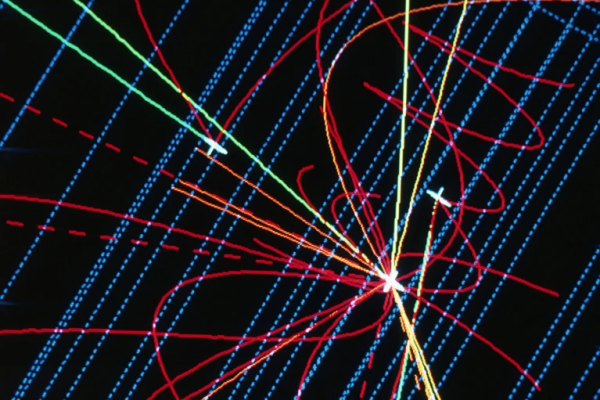Chip发表中科大丁冬生课题组最新成果:基于空分复用射频芯片模块的0.2 GHz~25 GHz超连续宽带双波段里德堡原子接收机
FUTURE远见| 2024-06-07
Future|远见
Future|远见future选编
近日,中国科学技术大学丁冬生课题组以「Ultra-wide dual-band Rydberg atomic receiver based on space division multiplexing radio-frequency chip modules」¹为题在Chip上发表研究论文,通过使用两个射频芯片集成式原子接收机模块同时处理不同波段的微波信号,实现了跨越6个倍频程(连续频率范围200 MHz到25 GHz)的超宽带双频微波信号接收。本文的第一作者为博士生张力华,通讯作者为丁冬生教授。Chip是全球唯一聚焦芯片类研究的综合性国际期刊,是入选了国家高起点新刊计划的「三类高质量论文」期刊之一。
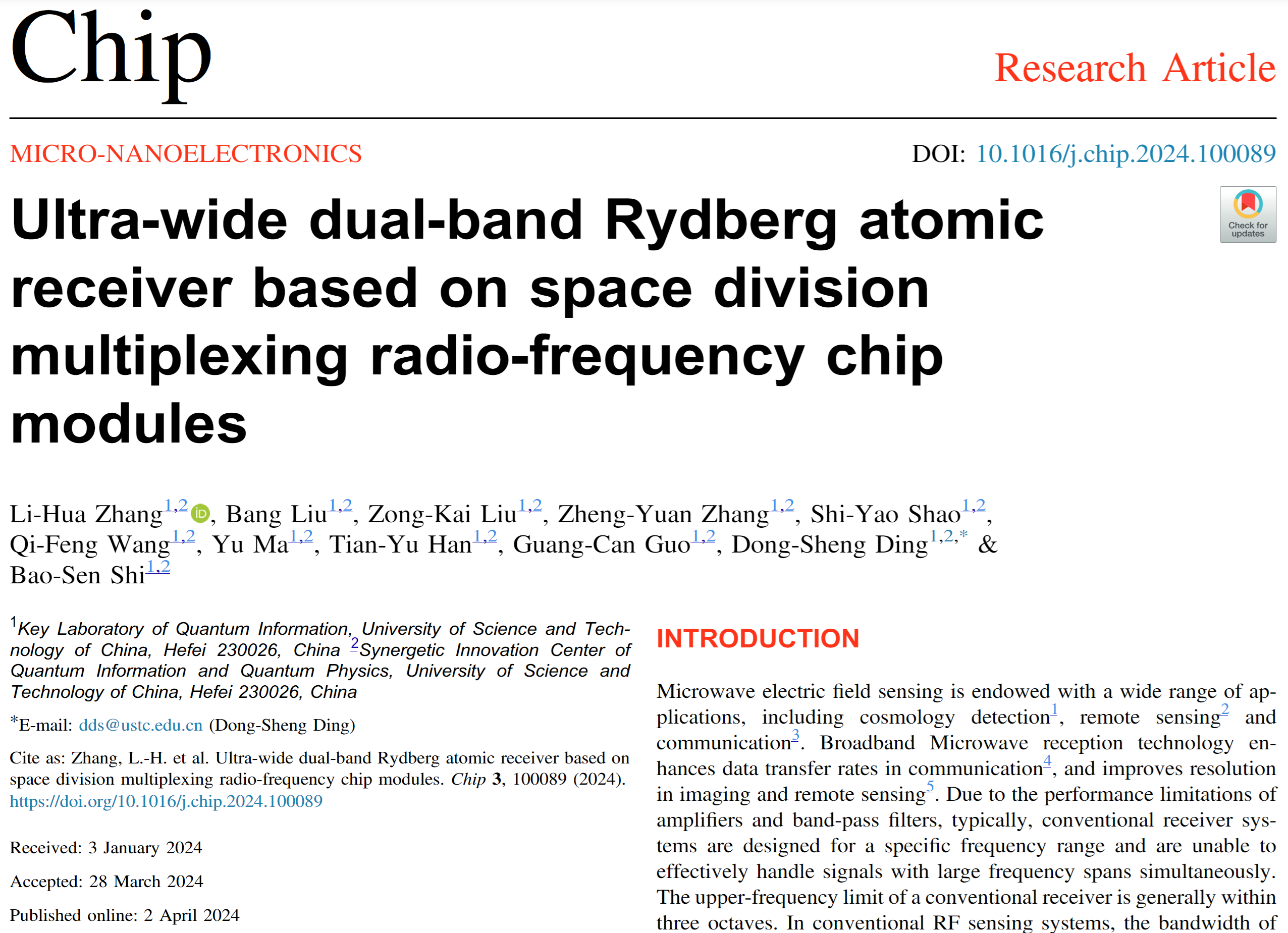
由于放大器、混频器和带通滤波器等电子器件的限制,传统微波接收系统通常工作在特定的频率范围内,无法同时高效地处理频率跨度较大的信号,因此传统微波接收系统能够实时接收的频率范围一般在三个倍频程内。里德堡原子具有能级结构丰富、相干时间长、极化率大等一系列优异物理性质,这些性质使得里德堡原子系统具有较宽的电场响应范围(从近直流到太赫兹)以及宽带范围较好的灵敏度²。发展基于里德堡原子的多频段微波探测系统有助于突破传统微波探测系统中的带宽限制,实现跨越较大频率范围的微波信号接收,提高通信、雷达等系统的频谱利用效率,适应不同应用场景的需求³。
近年来,世界上主要发达国家都对微波电场精密测量、里德堡微波传感等新型传感技术高度重视,例如:美国把基于里德堡原子的微波传感作为重要方向列入国防高级研究计划(Defence Advanced Research Programme,DARPA),成立了量子孔径计划,该计划的目是利用里德堡量子态实现量子孔径接收机来传感电场。美国陆军研究室、桑迪亚国家实验室等开展了相关研究,并取得了重要进展。例如:美国陆军实验室的Paul D. Kunz研究小组展示了一个基于里德堡原子与平面微波波导耦合的原子射频接收器和频谱分析仪⁴,他们使用非共振射频外差技术实现了0~20 GHz载波频率范围内的连续电场探测。通过连接标准兔耳天线,频谱分析仪可检测微弱的环境信号,包括相位调制(Frequency Modulation, FM)收音机、幅度调制(Amplitude Modulation,AM)收音机、WiFi和蓝牙等。
丁冬生课题组将射频芯片集成在里德堡原子系统中,有利于释放里德堡原子潜在的高电场测量灵敏度,实现了原子接收机系统的连续可调谐工作⁴。如图1b和图2a所示,课题组通过结合人工表面等离激元射频芯片的低损耗、场增强特性⁵⁻⁶以及里德堡原子微波探测系统的宽频带工作能力,设计了由原子气室和射频芯片构成的超宽带芯片集成式原子接收机模块,进一步基于该模块构建了双频带空分复用原子接收机系统。实验中,两个芯片集成式原子接收机模块通过低损耗射频线连接起来以实现信号共享,两个本振信号分别通过一对微波喇叭天线施加到芯片表面,然后与芯片表面的待测射频信号通过里德堡原子进行拍频,通过读取电磁感应透明(Electromagnetically induced transparency,EIT)光谱中的拍频信对待测射频信号进行探测。
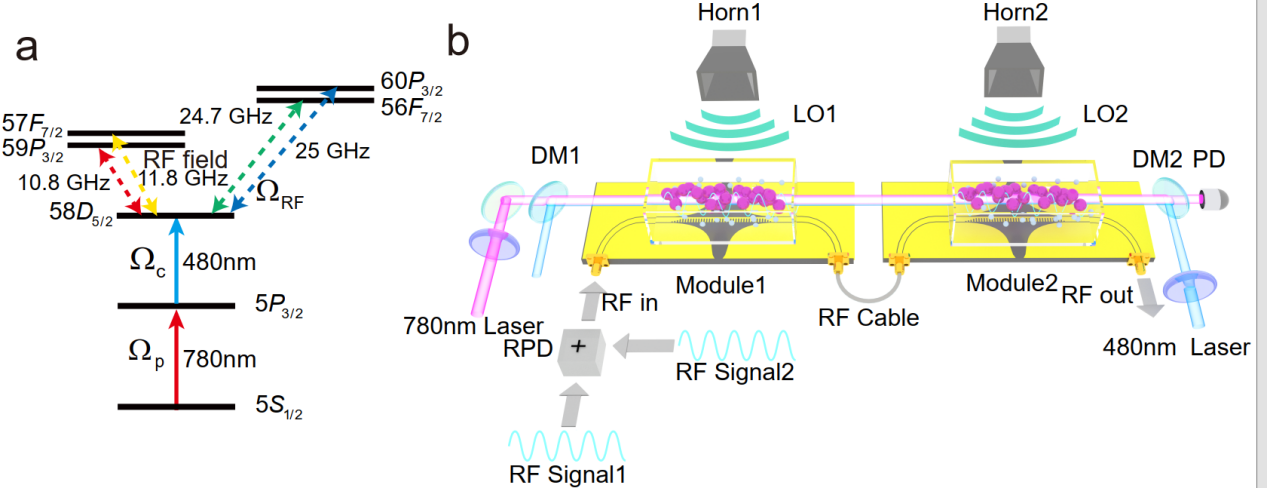
图1 实验能级图和装置图。a. 为实验中所使用的⁸⁵Rb原子的能级图。b. 为双光子里德堡原子EIT系统的光路图和空分复用的芯片集成式原子接收机系统结构图。
如图2b所示,通过利用里德堡原子的非共振响应以及调节两个本振射频信号的频率,在不调节激光频率的情况下,空分复用原子接收机系统中单个接收机模块的工作频率可以覆盖200 MHz到25 GHz 的超宽带范围。得益于空分复用接收方案和里德堡原子系统的低场扰动探测特点,该系统以较低的模块间串扰同时读出信号传输线路中不同频段的射频信号。图3a-3f展示了该系统接收到的不同中心频率的双波段射频信号频谱,其中图3f为系统同时接收中心频率为300 MHz和24 GHz的分别带有幅度调制和频率调制的射频信号频谱,展示了该系统具有跨越六个倍频程的多波段微波同时处理能力。通过连接传统天线,频谱分析仪可检测微弱的环境信号,包括收音机和WiFi信号等。这是既美国陆军实验室后的国内首个实现连续频率探测(激光器频率不改变的情况下)的里德堡原子接收系统,该工作的研究意义非常重大。
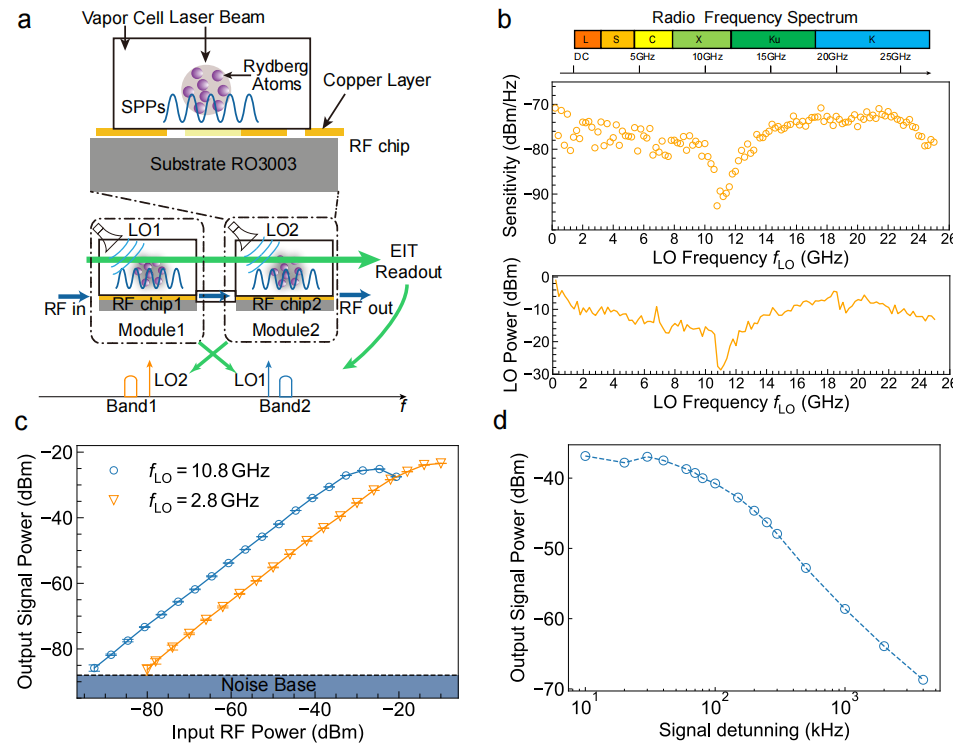
图2 系统工作原理图和接收机模块的基本参数。a. 为空分复用芯片集成式原子接收机实现双波射频接收原理图。b. 为单个接收模块的宽频响应。c. 为单个接收机模块在10.8 GHz和2.8 GHz处的动态范围(约为60 dB)。d. 展示了系统的瞬时带宽(3 dB带宽约为100 kHz)。
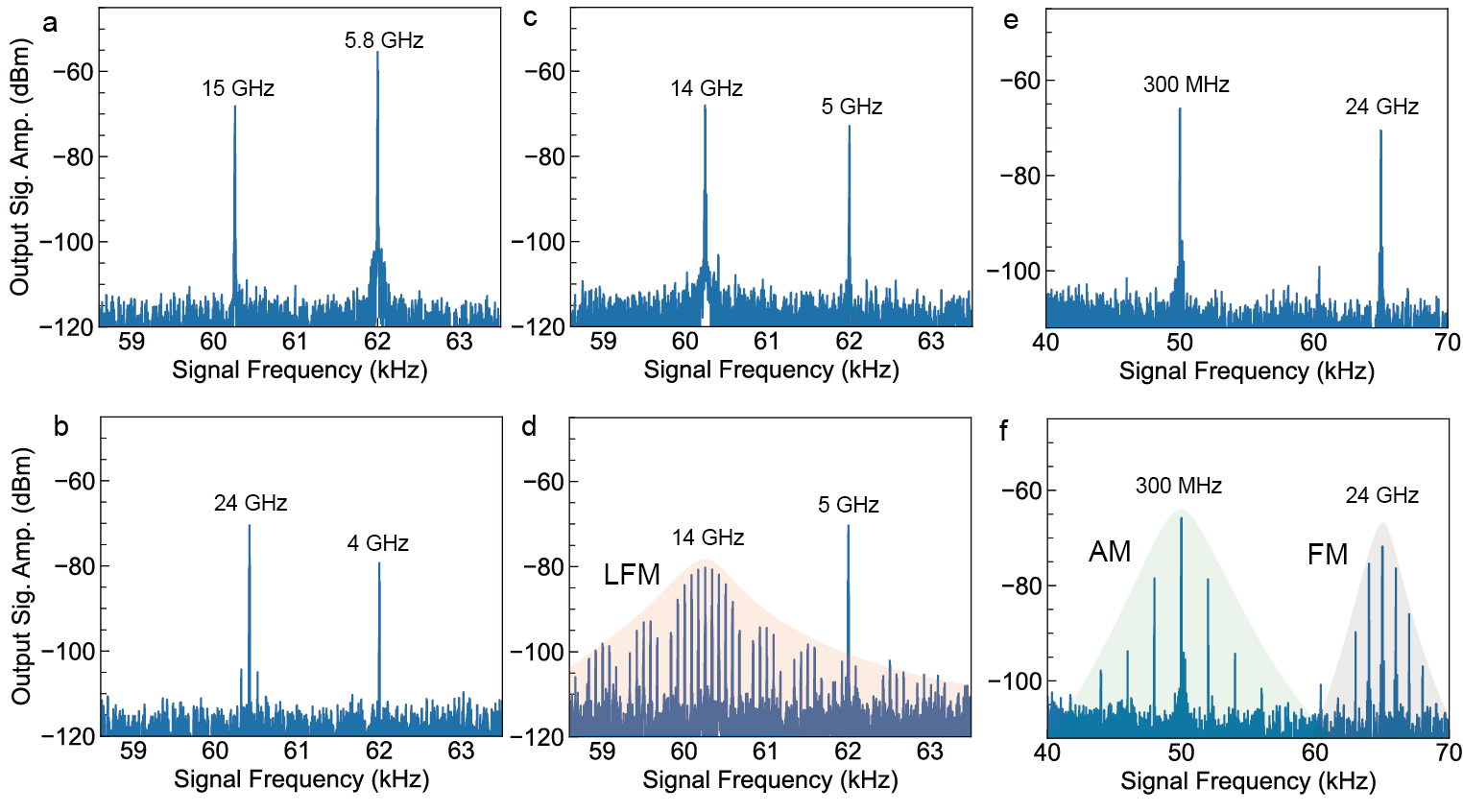 图3 系统接收到的不同中心频率双波段微波信号频谱。LFM:线性调频;AM:幅度调制;FM:相位调制。
图3 系统接收到的不同中心频率双波段微波信号频谱。LFM:线性调频;AM:幅度调制;FM:相位调制。Ultra-wide dual-band Rydberg atomic receiver based on space division multiplexing radio-frequency chip modules¹
Conventional microwave receiving systems are limited by the microwave components such as amplifiers, mixers and band-pass filters that can only operate efficiently in a specific frequency range. Typically, these systems can only process signals within a three-fold frequency range, which limits the data transfer bandwidth of the microwave communication systems. In contrast, Rydberg atomic antennas have specific advantages in radio frequency (RF) detection, such as high sensitivity, a wide operating frequency range (from DC to terahertz), and non-destructive detection, free of thermal noise². Developing novel atom-integrated microwave sensors, for example, RF-chip coupled Rydberg atomic receiver, provides opportunities for a large working bandwidth of microwave sensing at the atomic level and promotes the detection of microwave signals over a wide frequency which enables simultaneous transmission of a large amount of information and access to more spectrum resources. This capability is crucial for applications such as microwave communication, remote sensing, and radar³.
Here, the RF metawaveguide chip is integrated into the Rydberg atomic sensing system to extend the continuous working bandwidth of the atomic receiver⁴ (Fig.1, 2). And the low-loss and field-enhanced features of the metawaveguide are utilized to unleash the high-sensitivity potential of Rydberg atoms⁵⁻⁶. Based on this RF-chip-integrated design, a space-division multiplexing and modular dual-band microwave reception by detecting RF signals in two atomic receiver modules is demonstrated. The system can simultaneously receive dual-band microwave signals that span a frequency range exceeding 6 octaves (300 MHz and 24 GHz), as shown in Fig. 3. This work paves the way for multi-band microwave reception applications within an ultra-wide range by RF-chip-integrated Rydberg atomic sensor.
Fig. 1 | Experimental energy-level diagram and setup. a, The energy-level diagram of Rb atom (Rubidium 85). b,The multi-band microwave fields reception experiment setup. The whole detection system is composed of two receiver modules; each module consists of an RF chip and a centimeter-sized glass cell.

Fig. 2 | The performance of the single RF-chip-integrated Rydberg atomic receiver module. a, The structure of the RF-chip-integrated Rydberg atomic receiver. b, The intrinsic sensitivity for the RF-chip-integrated Rydberg system after a correction of the insert loss is plotted with red circles. Each datapoint is acquired with a frequency separation of 200 MHz.c, The system dynamic range at 2.8 GHz (blue circle) and 10.8 GHz (orange triangles). d, The system instantaneous bandwidth.

Fig. 3 | The arbitrary dual-band signal spectrum received simultaneously in two serial RF-chip-integrated atomic receiver modules. LFM, linear frequency modulation;AM:amplitude modulation;FM, frequency modulation.
参考文献:
1. Zhang, L.-H. et al. Ultra-wide dual-band Rydberg atomic receiver based on space division multiplexing radio-frequency chip modules. Chip 3, 100089 (2024).
2. Meyer, D. H., Castillo, Z. A., Cox, K. C. & Kunz, P. D. Assessment of Rydberg atoms for wideband electric field sensing. J. Phys. B: At. Mol. Opt. Phys. 53, 034001 (2020).
3. Al Abbas, E., Ikram, M., Mobashsher, A. T. & Abbosh, A. MIMO antenna system for multi-band millimeter-wave 5G and wideband 4G mobile communications. IEEE Access 7, 181916-181923 (2019).
4. Meyer, D. H., Kunz, P. D. & Cox, K. C. Waveguide-coupled Rydberg spectrum analyzer from 0 to 20 GHz. Phys. Rev. Appl. 15, 014053 (2021).
5. Liang, Y., Yu, H., Wang, H., Zhang, H. C. & Cui, T. J. Terahertz metadevices for silicon plasmonics. Chip 1, 100030 (2022).
6. Tang, W. X., Zhang, H. C., Ma, H. F., Jiang, W. X. & Cui, T. J. Concept, theory, design, and applications of spoof surface plasmon polaritons at microwave frequencies. Adv. Opt. Mater.7, 1800421 (2019).
论文链接:
https://www.sciencedirect.com/science/article/pii/S2709472324000078
作者简介

张力华,在读博士,目前在中国科学技术大学光学与光学工程系学习,师从丁冬生教授。张力华博士主要从事基于里德堡原子微波电场探测相关研究,长期解决里德堡原子宽频谱探测的科学问题。
Li-Hua Zhang, a PhD student, is currently studying in the Department of Optics and Optical Engineering, University of Science and Technology of China, under Professor Dong-Sheng Ding. Dr. Li-Hua Zhang is mainly engaged in the research based on measuring microwave electric field based on Rydberg atom, and solves the scientific problem of wide spectrum detection of Rydberg atom.

丁冬生,教授、博士生导师、国家优青(2017年)。主要从事基于里德堡原子的微波电场测量、基于里德堡原子的原子雷达、基于里德堡原子的量子模拟和量子计算、基于冷原子系统的量子存储等实验研究。以第一作者或者通信作者在国际顶尖期刊Nature子刊、Science子刊、PRL/X上发表多篇论文;丁冬生的课题组专注于解决国际前沿、国防技术等应用基础方面的科学问题,推进里德堡原子系统在雷达探测、量子物理等领域的发展;团队以量子力学和原子系统为中心,发展科技水平一流、符合国家重大战略需求的先进原子技术。
Dong-Sheng Ding is a professor in university of science and technology of china. His research involves electric field measurement, quantum simulation, and quantum storage based on Rydberg atoms. He publishes several papers in journals Nature Phyiscs, Nature Photonics, Science Advances, and PRL/X. Dong-Sheng Ding's group focuses on solving scientific problems in applications of international physical frontier and national defense technology, and promotes the development of Rydberg atomic system in radar detection, quantum physics and other fields.
关于Chip
Chip(ISSN:2772-2724,CN:31-2189/O4)是全球唯一聚焦芯片类研究的综合性国际期刊,已入选由中国科协、教育部、科技部、中科院等单位联合实施的「中国科技期刊卓越行动计划高起点新刊项目」,为科技部鼓励发表「三类高质量论文」期刊之一。
Chip期刊由上海交通大学出版,联合Elsevier集团全球发行,并与多家国内外知名学术组织展开合作,为学术会议提供高质量交流平台。
Chip秉承创刊理念: All About Chip,聚焦芯片,兼容并包,旨在发表与芯片相关的各科研领域尖端突破性成果,助力未来芯片科技发展。迄今为止,Chip已在其编委会汇集了来自14个国家的69名世界知名专家学者,其中包括多名中外院士及IEEE、ACM、Optica等知名国际学会终身会士(Fellow)。
Chip第三卷第一期已于2024年3月在爱思维尔Chip官网以金色开放获取形式(Gold Open Access)发布,欢迎访问阅读本期最新文章。
爱思唯尔Chip官网:
https://www.sciencedirect.com/journal/chip

